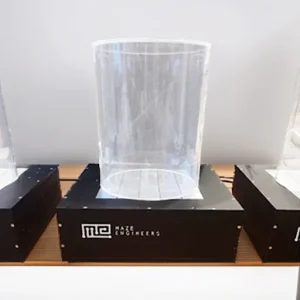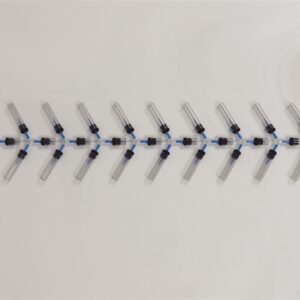$1,780.00
The MazeEngineers Drosophila Matrix opens up unparalleled avenues for Drosophila experimentation. Drawing inspiration from the pioneering research of De Bivort et al, these matrices offer a suite of distinctive functionalities:

MazeEngineers empowers preclinical neuroscience research with meticulously designed, customizable behavioral apparatuses. From manual classic mazes to fully automated smart systems, we provide the tools scientists need to capture high-quality, reproducible data for studies on learning, memory, anxiety, and depression.

bool(false)



The Drosophila Locomotion Matrix is engineered to delve into the intricacies of locomotor behavior in Drosophila. This behavioral phenomenon encompasses a nuanced form of lateralization, where behaviors are preferentially performed on one side of the body or with a distinct chiral orientation (Buchanan, 2015). Unlike genetic dominance or morphological asymmetry, locomotor handedness is intricately linked to the asymmetric processing of sensory input by the subject. Within the Drosophila Locomotion Matrix, varied light and pattern configurations are harnessed to scrutinize the impact of specific sensory stimuli on Drosophila’s locomotion. The Y-maze Matrix configuration serves as an expedient tool for assessing chemosensory responses in Drosophila (Simonnet, 2014), while the T-maze Matrix configuration facilitates examinations of memory retention (Malik, 2014) and phototaxic reflexes in adult flies (Swinderen, 2011). Through meticulous analysis of Drosophila locomotor behavior across diverse maze array configurations, researchers can begin to unravel the complexities underlying the variability in physiological, morphological, and behavioral traits exhibited by Drosophila reared in homogeneous environments (Buchanan, 2015).
The Drosophila Labyrinth Array comprises four distinct layers, each serving a particular function. At the base lies the foundation, crafted from translucent material and adorned with a subtle luminescent backdrop. Rising from this foundation, the second layer manifests as the maze’s enclosures, customizable to suit experimental specifications. Regardless of the maze’s design, the walls stand uniformly at a height of 1/16th inch. Encompassing the maze is the third layer, an infrastructure engineered to fortify the array, ensuring its structural integrity. Finally, the fourth layer culminates the ensemble with a lid fashioned from non-reflective acrylic, completing the maze array’s configuration.
The subjects are starved the for about 16 to 18 hours and are maintained at 25⁰C.
To maintain impartiality in design, every maze undergoes meticulous symmetry checks. For streamlined activity monitoring, Noldus Ethovision XT is positioned atop the apparatus, bathed in uniform illumination. At the experiment’s onset, individual flies are introduced to the Y-shaped layout, each maze impeccably illuminated and symmetrically arranged. Unrestrained movement is afforded to the subjects throughout the designated observation period, with scoring executed automatically. The assessment of turn bias score quantifies the duration spent by the fly in traversing the maze’s center and selecting the rightward direction (Buchanan et al., 2015).
Before entering the maze, flies must be housed and nourished at approximately 25°C with a humidity level of around 70%. A gentle air pump must be affixed to the T-maze to facilitate the circulation of odors across the flies, with airflow maintained at approximately 2 L/min. Two distinct odors, 4-methylcyclohexane (diluted at 1:67) and 3-octanol (diluted at 1:100) in mineral oil, should be utilized. Each odor solution (approximately 30µl) is carefully dispensed into a specialized odor cup, nestled within an odor block and covered by a perforated plastic tube to enable airflow over the cup. Experimental sessions should be conducted under subdued red lighting, enabling researchers to observe while preventing visual distraction for the flies, allowing them to focus solely on olfactory cues.
The T-maze session commences with flies acclimating to the airflow within the apparatus for a duration of 90 seconds. Subsequently, the initial odor is introduced into the maze, accompanied by a 60-volt shock lasting 60 seconds. A brief interlude of 30 seconds ensues, devoid of both odor and shock stimuli. Following this intermission, the second odor permeates the maze for 60 seconds, unaccompanied by a shock. The flies are then transitioned from the training tube to the central chamber of the T-maze, where they remain for 90 seconds. To gauge the flies’ learning, they are guided to the choice point of the T-maze and simultaneously exposed to both odors, prompting them to navigate towards one. This assessment spans 120 seconds, during which the flies are confined within the choice tubes. Subsequently, flies from each arm of the T-maze and the central compartment are collected in food vials and tallied to assess learning retention. For memory evaluation, flies are retrieved post-training and reintroduced to the T-maze, with performance index results calculated using the formula: (#CS– flies – CS+ flies) / (# total flies). Post-experiment, the odor cups are meticulously cleaned with hot water and odorless detergent (Malik, 2014).
In their study conducted in 2014, Malik and colleagues delved into the intricate molecular pathways governing various memory phases in Drosophila melanogaster. Employing a T-type configuration, they investigated the impact of factors such as aging, circadian rhythms, sleep patterns, as well as interventions involving drugs and neurodegenerative diseases on memory retention.
The Y-maze Array configuration is an efficient test to evaluate the chemosensory responses in Drosophila (Simonnet, 2014).
Researchers Alcorta and Rubio (1998) utilized the Y-type configuration to explore intrapopulation genetic diversity concerning olfactory responses to odor stimuli. By coupling stimuli with the maze, researchers gain insight into the locomotor behavioral traits of flies reared in indistinguishable environments. Such investigations shed light on the fundamental understanding of how genetically identical individuals exhibit variability in their physiology, morphology, and behavior, providing valuable insights into the mechanisms underlying phenotypic diversity.
Buchanan et al. 2015 studied locomotor handedness in Drosophila melanogaster.
The maze can be modified to include both “+” and “-” configurations.
Number of flies loaded = 14 |
Number of flies in odor tube = 10 |
Number of flies in solvent tube = 4 |
Olfactory index formula: (number in the odor tube – number in the solvent tube)//total number of loaded flies |
Olfactory index: (10-4)/14 = 0.429 |
Adaptable to various configurations such as T, Y, and others, the Drosophila Maze Array proves versatile, catering to the unique requirements of diverse research endeavors. Serving as a versatile platform, it facilitates the exposure of Drosophila flies to a plethora of stimuli including odor, light, and shock waves, enabling meticulous investigations into the locomotor behavior of the subjects.
The limitations associated with a Drosophila Maze Array is that they are limited to odor and visual stimuli, and would need to be modified to allow for testing using other stimuli. Drosophila Maze Arrays must be used in controlled environments with minimized external factors.
Buchanan, Sean M. Kain, Jamey S., and de Bivort, Benjamin L. (2015). Neuronal Control of Locomotor Handedness in Drosophila. PNAS, vol 112 (no. 21), p. 6700-6705.
Malik, Bilal R., and Hodge, James J.L. (2014). Drosophila Adult Olfactory Shock Learning. Journal of Visualized Experiments, vol. 90 (e50107), p. 1-5.
Martin, Fernando, Charro, Maria J., and Alcarta, Esther. (2001). Mutations Affecting the cAMP Transduction Pathway Modify Olfaction in Drosophila. J. Comp Physiol A, p. 359-370.
Simonnet, Megane M., Berthelot-Grosjean, Martine, Grosjean, Yael. (2014). Testing Drosophila Olfaction with a Y-maze Assay. Journal of Visualized Experiments, vol. 88 (e51241), p. 1-4.
Swinderen, Bruno van. (2011). Aversive Phototaxic Suppression Assay for Individual Adult Drosophila. Cold Spring Harbor Protocols, p. 1203-1205.
Alcorta E, Rubio J. (1989). Intrapopulational variation of olfactory responses in Drosophila melanogaster. Behav Genet ;19(2):285-99.
| Drosophila Maze Array | – (25 units), + (25 units), T (25 units), Y (25 units) |
|---|
There are no questions yet. Be the first to ask a question about this product.